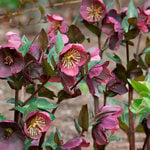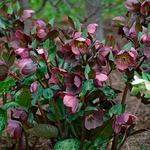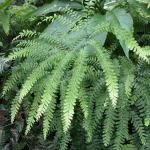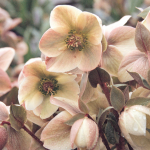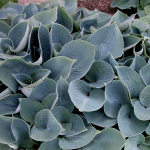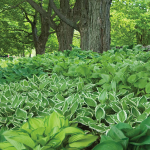Product Details
Wake the garden early from winter with our exclusive Snow Chaser Hellebore Trio, a collection of three high-performance favorites. Emerging from the last snows of winter, the large flowers of Helleborus Frostkiss® Pippa's Purple (PP 27,121) are purple-pink speckled in maroon. The blossoms are held erect and outward on dark purple stems, capping a mound of soft green foliage that is elegantly marbled in white. Helleborus Frostkiss® Penny’s Pink (PP 24,149) is named for English plantswoman and author Penelope Hobhouse. Its evergreen leaves have pronounced veining that is silver- or fuchsia-toned in spring then gold or emerald as the season progresses. Atop the foliage, purple buds give way to saucer-shaped, pale pink blossoms that intensify in color as they age. The flowers hold their color from late winter well into spring. Helleborus Frostkiss® Molly's White (PP 25,685) offers up greenish white blossoms on tall stems, a winter bouquet that tops a tidy, compact mound of moss green, evergreen foliage veined in silvery white. Give these plants a season to settle in. The display of foliage and flowers will become a highlight of the early garden. 3 plants total.
Shipping
HOW PLANTS ARE SHIPPED
The size of the plants we ship has been selected to reduce the shock of transplanting. For some, this means a large, bareroot crown. Others cannot travel bareroot or transplant best if grown in containers. We ship these perennials and annuals in 1 pint pots, except as noted. We must point out that many perennials will not bloom the first year after planting, but will the following year, amply rewarding your patience. We ship bulbs as dormant, bare bulbs, sometimes with some wood shavings or moss. Shrubs, Roses, vines, and other woody plants may be shipped bareroot or in pots. The size of the pot is noted in the quick facts for each item.
WHEN WE SHIP
We ship our bulbs and plants at the right time for planting in your area, except as noted, with orders dispatched on a first-come, first-served basis by climate zone. We also ship a wide range of containers and planters, tools, supplies, fertilizers, garden wear, garden decor items, as well as indoor decorations like wreaths and dried bouquets when available. Estimated dates for shipping are indicated in the green Shipping Details box for each item. Please supply a street address for delivery. Kindly contact us with two weeks notice, if you'll be away at the expected time of delivery.
OUR GUARANTEE
We guarantee to ship plants that are in prime condition for growing. If your order is damaged or fails to meet your expectations, we will cheerfully replace or refund it. Please contact our Customer Service Department at 1-800-503-9624 or email us at [email protected]. Please include your order number or customer number when contacting us.
Reviews
There are no reviews yet. Be first to Write a Review.
Growing guide
Latin Name Pronunciation: hel-eh-bor'us
These evergreen plants bring an architectural quality to the shady garden. Most bloom in early winter in mild climates and in late winter or very early spring where the ground freezes hard. Resistant to both deer and voles, they are long-lived and provide exquisite blooms at a time when flowers are a scarce delight.
Light/Watering
- Hellebores are at their best in evenly moist well-drained soil in partial shade.
- Water well during extended dry periods; they are drought-tolerant once established.
Fertilizer/Soil and pH
- Hellebores grow best in soil enriched with copious amounts of organic matter.
- The hybrids known as Helleborus x hybridus (previously called Helleborus orientalis) prefer a soil pH close to neutral and even alkaline; add lime if your soil is extremely acid.
- The Christmas Rose (H. niger) may be slow to become established; to help it along, try a dose of magnesium in the form of Epsom salts or dolomitic limestone sprinkled around the plants.
- Plants will benefit from a light application of granular, balanced fertilizer in early spring.
Pests/Diseases
Watch for slug or snail damage, and control with baits or diatomaceous earth.
Cutting FlowersTo enjoy the blossoms indoors, you can simply cut off the flowers and float them in a shallow bowl of water. To use them in bouquets, cut the stems of older blooms that have dropped their stamens (tiny, stalk-like filaments in the center of the blooms) and started to produce small round seed pods.
Companions
Hellebores are lovely with other denizens of light shade such as:
- Ferns
- Tiarella
- Campanula
- Alchemilla
- Hosta
- Phlox divaricata
- Pulmonaria
They truly enliven woodland gardens. The larger, more exuberantly colored varieties or double forms are a great addition to the shady border.
Pruning
- Although evergreen, the foliage often looks tattered in early spring. Prune back dead and disfigured foliage before new growth appears.
- Remove old flower stems when they decline, cutting back to basal foliage, but take care not to remove the stems of Bear’s-foot Hellebore (H. foetidus), because they carry the flower buds formed in the previous growing season.
- If seedlings are not desired, remove old flowers before seed is set.
Dividing/Transplanting
Although plants may be slow to settle in, once they do, they rarely need division and may resent it.
End-of-Season Care
- Do not prune back now; wait until early spring.
- Mulch with salt marsh hay if desired.
Calendar of Care
Early Spring
- Apply a light application of balanced or slow-release fertilizer or side-dress with compost and organic amendments when new growth appears.
- H. niger may benefit from a side-dressing of Epsom salts or dolomitic lime.
- Prune back old foliage to make room for new growth.
- Transplant now if desired.
Mid-Spring
- Water well if it is unseasonably dry as plants prefer evenly moist soil.
Late Spring
- Watch for slug or snail damage and control if necessary.
- Remove old flower stems as they decline, and deadhead if seedlings are not desired.
Summer
- Pull out any unwanted new seedlings as hybrids may not come true from seed; move desirable species seedlings to permanent locations.
- Groom plants by removing yellow or dead leaves.
Fall
- Add lime to acid soil for H. x hybridus if a soil test shows a pH under 7.0.
- Do not prune back for winter
- A light mulch of salt marsh hay may be beneficial.

